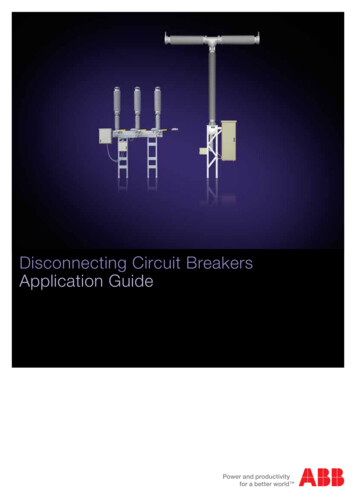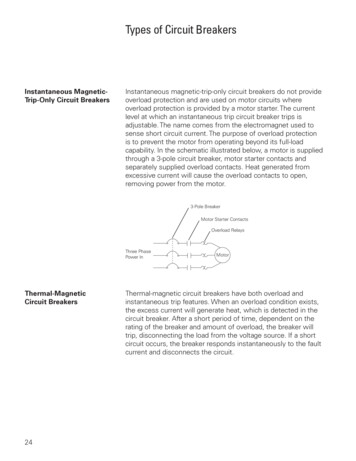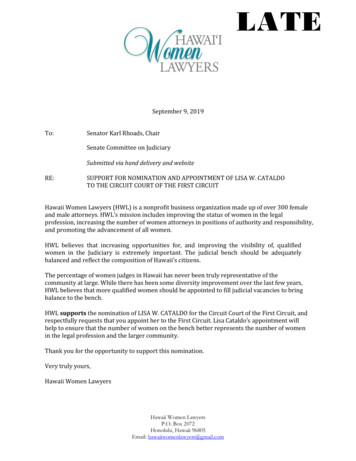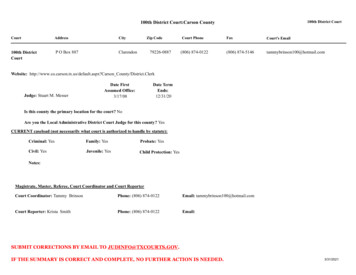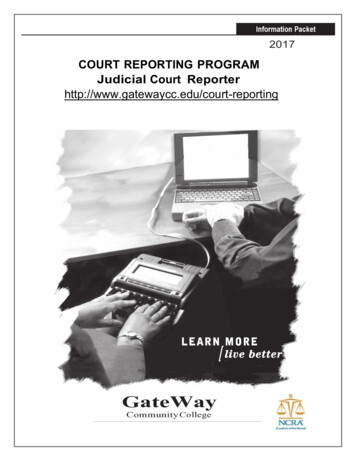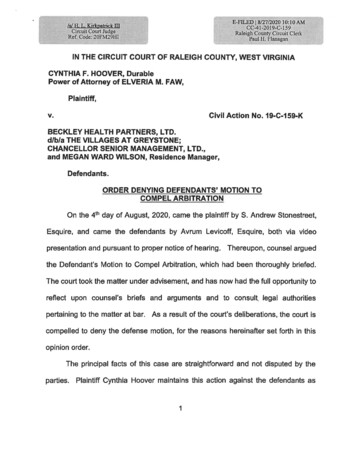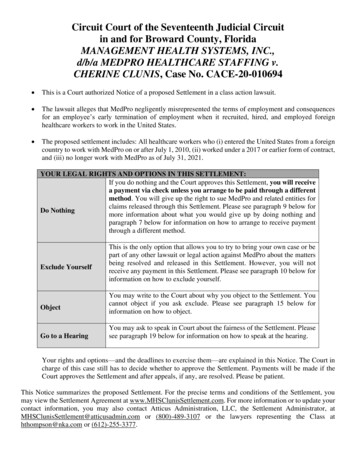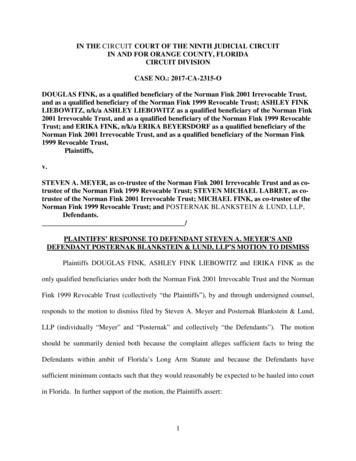
Transcription
IN THE CIRCUIT COURT OF THE NINTH JUDICIAL CIRCUITIN AND FOR ORANGE COUNTY, FLORIDACIRCUIT DIVISIONCASE NO.: 2017-CA-2315-ODOUGLAS FINK, as a qualified beneficiary of the Norman Fink 2001 Irrevocable Trust,and as a qualified beneficiary of the Norman Fink 1999 Revocable Trust; ASHLEY FINKLIEBOWITZ, n/k/a ASHLEY LIEBOWITZ as a qualified beneficiary of the Norman Fink2001 Irrevocable Trust, and as a qualified beneficiary of the Norman Fink 1999 RevocableTrust; and ERIKA FINK, n/k/a ERIKA BEYERSDORF as a qualified beneficiary of theNorman Fink 2001 Irrevocable Trust, and as a qualified beneficiary of the Norman Fink1999 Revocable Trust,Plaintiffs,v.STEVEN A. MEYER, as co-trustee of the Norman Fink 2001 Irrevocable Trust and as cotrustee of the Norman Fink 1999 Revocable Trust; STEVEN MICHAEL LABRET, as cotrustee of the Norman Fink 2001 Irrevocable Trust; MICHAEL FINK, as co-trustee of theNorman Fink 1999 Revocable Trust; and POSTERNAK BLANKSTEIN & LUND, LLP,Defendants./PLAINTIFFS’ RESPONSE TO DEFENDANT STEVEN A. MEYER’S ANDDEFENDANT POSTERNAK BLANKSTEIN & LUND, LLP’S MOTION TO DISMISSPlaintiffs DOUGLAS FINK, ASHLEY FINK LIEBOWITZ and ERIKA FINK as theonly qualified beneficiaries under both the Norman Fink 2001 Irrevocable Trust and the NormanFink 1999 Revocable Trust (collectively “the Plaintiffs”), by and through undersigned counsel,responds to the motion to dismiss filed by Steven A. Meyer and Posternak Blankstein & Lund,LLP (individually “Meyer” and “Posternak” and collectively “the Defendants”). The motionshould be summarily denied both because the complaint alleges sufficient facts to bring theDefendants within ambit of Florida’s Long Arm Statute and because the Defendants havesufficient minimum contacts such that they would reasonably be expected to be hauled into courtin Florida. In further support of the motion, the Plaintiffs assert:1
INTRODUCTION1. All that is necessary for this court to confirm that Meyer and Posternak have submittedthemselves to the jurisdiction of this court, the court need find only that the settler of the trustwas a Florida resident when the trusts were created, or that the Defendants have established suchminimum contacts that they should know they could be hauled into court in the forum. Sinceboth are true here, the Defendants’ motion should be denied.ARGUMENTI.The Court has personal jurisdiction over Meyer under the Florida Trust Codelong-arm statute.2. Beginning with the Trust documents themselves, it should be noted that Meyeracknowledges in both trusts that Norman Fink, his client and the settler of the trusts, was aresident of Florida when the trusts were created:3. Next, Meyer himself dictated that Florida law would govern his client’s trust as alleged in¶ 12 of the complaint:2
4. Finally, it is undisputed that Meyer acts as co-trustee for both trusts and has, in fact,refused to resign as trustee for either trust.5. It is black letter law that this Court has personal jurisdiction over a “trustee of a trustcreated by a settlor who was a resident of [Florida] at the time of creation of the trust.” §736.0202(2)(a)(3), Fla. Stat. Since it is undisputed that Norman Fink was a Florida residentwhen the two trusts were created and that Meyer acts as co-trustee of both trusts, the Court haspersonal jurisdiction over Meyer under the Florida Trust Code Long-Arm Statute.6. The Defendants’ argument regarding the retroactive application of the Florida TrustCode’s long-arm statute, enacted in 2013, misses the mark. This argument presupposes long-armjurisdiction fixed when Meyer accepted Trusteeship in 2007, rather than when the Defendantswas served with process, or when they challenged personal jurisdiction in this matter.7. But the Florida Trust Code makes clear that the statute was written to provide Floridacourts with jurisdiction over trust matters in every instance in which jurisdiction is notunconstitutional under the State or Federal constitutions. See 736.0202(2)(b), Fla. Stat. Thelanguage of this statute, bifurcated between an enumerated acts portion (§ 736.0202(2)(a)) and3
the catch-all provision (§736.0202(b)), makes clear that the legislative intent behind this statutewas to modify the rules for adjudicating a preexisting remedy, rather than create a newsubstantive right, thereby creating a presumption that the statute applies retroactively. SeeMcGee v. International Life Insurance Co., 355 U.S. 220, 224 (1957) (applying a long-armstatute enacted after two parties signed the contract at issue because the statute “did nothingmore than to provide petitioner with a [state] forum to enforce whatever substantive rights shemight have against respondent.”); Landgraf v. USI Film Prods., 511 U.S. 244, 275 (1994)(“Changes in procedural rules may often be applied in suits arising before their enactmentwithout raising concerns about retroactivity.”). See also Gordon v. John Deere Co., 264 So. 2d419 (Fla. 1972) (finding that where new substantive rights are created by the long-arm statutes,they apply prospectively).II.The Court has personal jurisdiction over the Defendants under Florida’s generallong-arm statute.8. Even if the Court were to find that the Florida Trust Code’s long arm statute does notapply retroactively and therefore that the Court does not have personal jurisdiction over Meyerunder § 736.0202(2)(a)(3), this Court may nevertheless exercise personal jurisdiction over him“to the maximum extent permitted by the State Constitution or Federal Constitution.” §736.0202(b), Fla. Stat. In other words, the Court has jurisdiction over Meyer if he comes withinambit of Florida’s general long arm statute.9. Long-arm statutes provide personal jurisdiction so long as the defendant’s activity withinthe state is sufficient to satisfy the constitutional minimum contacts analysis. § 48.193(1)(a), Fla.Stat. See also Venetian Salami Co. v. Parthenais, 554 So. 2d 499, 502 (Fla. 1989). Furthermore,Florida Statute Section 48.193(2) provides that a defendant is subject to personal jurisdiction inFlorida if it is “engaged in substantial and not isolated activity” within the State. “Substantial4
and not isolated” activity has been defined as “continuous and systematic general businesscontact” with Florida. See Caiazzo v. Am. Royal Arts Corp., 73 So. 3d 245, 250 (Fla. 4th DCA2011).10. And by consistently billing and collecting payment for work done on behalf of multipleFlorida residents (including the Plaintiffs and Norman Fink) for over a decade, Meyer hassufficiently satisfied the constitutional minimum contacts analysis. Furthermore, such conductby Meyer consists of sufficient “minimum contacts” with Florida that Posternak should havereasonably anticipated it would be “hauled into court” in Florida because of its agencyrelationship with Meyer. World-Wide Volkswagen Corp. v. Woodson, 444 U.S. 286 (1980); seealso § 48.193(1)(a) (any person “through an agent does any of the acts enumerated in thissubsection thereby submits to the jurisdiction of the courts of this state for any cause of actionarising from any of the following acts. . . carr[ies] on a business or business venture in this state”(emphasis added)).Posternak and Meyer collected at least 190,000.00 from Norman Fink’sestate probate – despite the fact that the estate was administered in Florida.11. On March 25, 2008, a mere fifteen months after Norman Fink’s death, Meyer signed andfiled an IRS Form 706 which provides extensive proof of the vast extent of the vast extent of thework Meyer was doing and the contacts he had with Florida12. Keeping in mind first that Norman Fink's Estate opened and closed in Volusia County, itshould be noted initially the very large sum of money charged by Posternak and Meyer for "legalservices in connection with estate administration" as alleged in ¶ 75 of the complaint:5
13. The expense indicated by Posternak is particularly noteworthy when compared to theexpense shown by the Florida firm that was actually listed as the attorney of record for thisFlorida estate14. Importantly, the domicile of the decedent and address of executor were both in Florida:15. As such, both Meyer and Posternak established sufficient minimum contacts with Floridanearly a decade ago.6
Meyer’s own affidavit reveals that both he and Posternak have substantialbusiness contact with Florida.16. Furthermore, Meyer’s affidavit admits his continuous and systematic general businessties to Florida.Indeed, Meyer admits that “[s]ervice as a trustee has been a regular andsignificant part of my compensated professional services” and that he has acted as trustee forthree trusts created by Florida settlors:17. So in addition to Norman Fink, Meyer has acted as a trustee for other Florida residents.And acting as trustee is apparently how Meyer makes a substantial portion of his living. Thisadmission alone warrants a finding that Meyer and Posternak come within purview of Florida’sgeneral long arm statute.The affidavits filed in opposition to the Defendants’ motion evidencefurther continuous and systematic general business contact with the forum.18. As detailed in the affidavits filed in opposition to the Defendants’ motion, two of thedecedent's children who are beneficiaries of the Estate and Trusts, lived in Florida and thoseaffidavits reveal the extent to which Meyer and Posternak were involved in complex transactionsimmediately after Fink's death:7
19. Ashley Fink's affidavit in particular asserts that she had extensive dealings with Meyerencompassing a broad range of transactions related to her father’s estate and the Form 706reveals some of those transactions.20. Even though these transactions occurred more than a decade ago, the affidavits and therecords that were recently obtained show that Meyer and Posternak engaged in extensivecontacts and dealings in the jurisdiction for the whole decade.Posternak’s and Meyer’s own records admit continuous and systematicgeneral business contact with the forum.21. The primary thrust of their complaint is that the three children and beneficiaries ofNorman Fink's estate were completely unaware of the full extent of these transactions or thecosts borne by them because they had never received the annual accountings they are entitled tounder the Florida Trust Code. See §§ 736.0813 and 736.08135, Fla. Stat. Indeed, had theyreceived these annual accountings, the Plaintiffs would have been alerted to the costs and to thefull extent of Meyer and Posternak's dealings with this Florida Jurisdiction.22. Even as of the date of filing this motion, the three beneficiaries have no real idea what thetrue value of the assets that were left to them when their father died in 2006. And because they8
were not provided yearly accountings, they could not see how these assets or the value of thetrusts increased or decreased. They never saw any attorneys’ fee or trustees’ fee invoices. But inany event, the accountings they began to receive in 2016 and only after retaining counsel, beginto reveal, for the very first time, the full extent of the continuous and systematic general businesscontact both Meyer and Posternak have with Florida as evidenced by just a few examples below:23. In the 1999 Trust, Norman Fink provides that his former girlfriend and Florida residentMaria Baker was to receive 325,000.9
24. But as detailed in Plaintiff's complaint, when comparing the 1999 accounting with theattorney fee invoices supplied by Meyer, it appears that rather than distribute this money directlyto Baker, Meyer and Posternak paid vast sums of money to themselves, in compensation forwork that they did, purportedly on her behalf, while she was a resident of Volusia County,Florida – and all the way through at least the year 2014:10
25. And as further alleged in the complaint, the detailed attorney fee billing provided byMeyer and Posternak reveal that they spent hours upon hours engaging in work that wouldclearly be categorized as practicing law here in Florida, and work that would more accurately bedescribed as guardianship or social work.11
26. There is no evidence that Baker ever hired Meyer or Posternak to serve as her attorneys,guardian or social worker, but the billing reveals that the performed extensive work for years;billed aggressively for this work; and were compensated handsomely.27. Likewise, Meyer and Posternak took it upon themselves to serve as Doug Fink’s guardianand fiduciary while he was a resident of Daytona Beach, Florida. Indeed, the accountings revealthat Meyer did not merely act as a trustee who prudently distributed the money Doug Fink wasentitled to as a beneficiary of his father's trust, but instead Meyer acted as Doug Fink'sunauthorized guardian and fiduciary, personally involving himself in the most mundane andintimate details of this adult's life (all the while charging ever vastly accumulating fees).28. A tiny sampling of those expenses are detailed in the Plaintiffs’ complaint, but the 2001accounting provides more details that hint at the extensive unauthorized guardianship and legalwork that Meyer has been engaged in for more than a decade. But most important for purposes12
of the jurisdictional analysis is the extensive work Meyer and Posternak performed while DougFink was a resident of Volusia County Florida.29. As detailed in his attached affidavit Doug Fink never hired Meyer as his attorney, henever consented or authorized Meyer to act as his guardian and yet for years Meyer insertedhimself into every single aspect of his life. The detailed attorney fee billing below support(among other things) Doug Fink's assertions that: Meyer placed Fink's utility, water and cable accounts into Meyer's own name (f/b/o DougFink) and engaged in account negotiations and disputes related to those accounts whichall existed here in Florida;Meyer negotiated with and paid health care and mental health providers and physiciansthat treated both Doug Fink and his minor daughter;Meyer retained and paid attorneys on Doug Fink's behalf and engaged in extensive legalconsultations, strategies and discussions with those attorneys. Meyer even traveled toDaytona Beach to personally meet with attorney Aaron Delgado who represented Fink,but Meyer refused to allow Fink to attend that meeting.30. In short, Posternak’s and Meyer’s own records reveal that rather than simply provide trustmonies that Doug Fink was entitled to directly to Fink, Meyer insisted on engaging directly withmerchants, day care providers, vendors and professionals, paying Fink's personal expenses withMeyer's own personal credit card:13
14
15
31. Furthermore, in 2016 counsel for Fink received documents from Posternak that supportsome of the charges attributed to Doug Fink. Contained within those thousands of pages arehundreds of examples that detail the extensive work Meyer has been engaged in on Doug Fink'sbehalf while in the State of Florida:16
Evidence of involvement in a security deposit/rent dispute: Evidence of power bill in Doug Fink's name mailed to Meyer:17
Reimbursing Doug Fink's wife for child care expenses: Meyer using his personal credit card to pay Doug Fink’s furniture expenses:18
19
Meyer/Posternak writing checks related to utility and cable accounts for bills in Florida32. Over and over again, hundreds of pages long, going for years, Meyer using his personalcard to pay Doug Fink expenses and engage with literally dozens of businesses and individualson Doug's behalf, then Meyer reimbursing himself from attorney's trust accounts and client fundsaccounts:20
33. Meyer engaged in negotiations, disputes and discussions with vendors and serviceproviders on Doug Fink's behalf; paid for those services on Meyer's personal credit cards; andthen reimbursed and enriched himself with trust funds, all while Doug Fink was a Floridaresident:21
Meyer paying Doug Fink’s motorcycle expenses22
Meyer engaging a Florida attorney, Anthony Delgado, to represent Doug Fink. Internal Posternak document where Meyer requests that Fidelity wire the money used topay Doug Fink's attorney fee retainer back into an account held by Meyer and his wifeChana Meyer:23
Meyer using Doug Fink's Florida attorney as an intermediary to provide a 100 moneyorder Over and over again, year after year, on a monthly basis, stretching for years, Meyerusing his personal credit card to negotiate and pay for medical care and monthly utilities,then seeking reimbursement for those expenses, (and charging hourly fees):24
25
The excruciating detail Meyer would require before releasing money, Meyer wiring thesefunds to Florida then requesting that the funds be returned to a personal accountmaintained by he and his wife:26
The cumulative weight of what is known now, even before discovery,extends far, far beyond “minimum contacts” but evidences extraordinaryand repetitive contacts with the forum.34. The receipts and back up documentation, the attorney fee billing statements, the IRSforms, along with emails and other documents which the Plaintiffs have only recently come intopossession of reveal not just the “minimum contacts” the law requires to find that Stephen Meyerand Posternak should expect could find them being hauled into court in Florida but reveal theextraordinary depths with which Meyer and his firm inserted themselves into extensive consumertransactions and disputes, the medical and health care decision making over the lives of thePlaintiffs, their dependents, and other trust beneficiaries – all of whom were Florida residents.35. Over the course of these years and thousands of transactions, numerous disputes werecaused. Utilities were turned off, with late fees assessed. Rent payments were late and otherconflicts developed causing additional conflicts. Doug Fink's legal affairs were compromised byMeyer's interference with Fink's own relationships with his attorneys.36. In short, the Plaintiffs need only show sufficient minimum contacts and the Defendants’own documents go far beyond this de minis showing.CONCLUSIONThe Court should deny the Defendants’ motion and order that they answer the complaintwithin 10 days.27
Dated: July 27, 2017Weidner Law, P.A.Counsel for Plaintiffs250 Mirror Lake Dr., N.St. Petersburg, FL 33701Telephone: (727) 954-8752Designated Email for Service:service@mattweidnerlaw.comBy: s/ Matthew D. WeidnerMatthew D. Weidner, Esq.Florida Bar No. 18595728
CERTIFICATE OF SERVICE AND FILINGI HEREBY CERTIFY that a true and correct copy of the foregoing was served this July27, 2017 to all parties on the attached service list. Service was by email to all parties not exemptfrom Rule 2.516 Fla. R. Jud. Admin. at the indicated email address on the service list, and byU.S. Mail to any other parties. I also certify that this document has been electronically filed thisJuly 27, 2017.Weidner Law, P.A.Counsel for Plaintiffs250 Mirror Lake Dr., N.St. Petersburg, FL 33701Telephone: (727) 954-8752Designated Email for Service:service@mattweidnerlaw.comBy: s/ Matthew D. WeidnerMatthew D. Weidner, Esq.Florida Bar No. 185957SERVICE LISTThomas A. ZehnderVincent Falcone IIIKING, BLACKWELL, ZEHNDER &WERMUTH, P.A.P.O. Box 1631Orlando, FL e@kbzwlaw.comcourtfilings@kbzwlaw.comCounsel for Steven A. Meyer and PosternakBlankstein & Lund LLPTodd Norman, Esq.Benjamin J. Robinson, Esq.BROAD AND CASSEL LLP390 N. Orange Ave, Ste. 1400Orlando, FL adandcassel.comchoward@broadandcassel.comCounsel for Michael FinkCharles J. Meltz, Esq.GROWER, KETCHAM, EIDE, TELAN &MELTZ, P.A.P.O. Box 538065Orlando, FL am.comjclinton@growerketcham.comCounsel for Steven Michael Labret29
the detailed attorney fee billing below support (among other things) doug fink's assertions that: meyer placed fink's utility, water and cable accounts into meyer's own name (f/b/o doug fink) and engaged in account negotiations and disputes related to those accounts which all existed here in florida; meyer negotiated with and paid health




